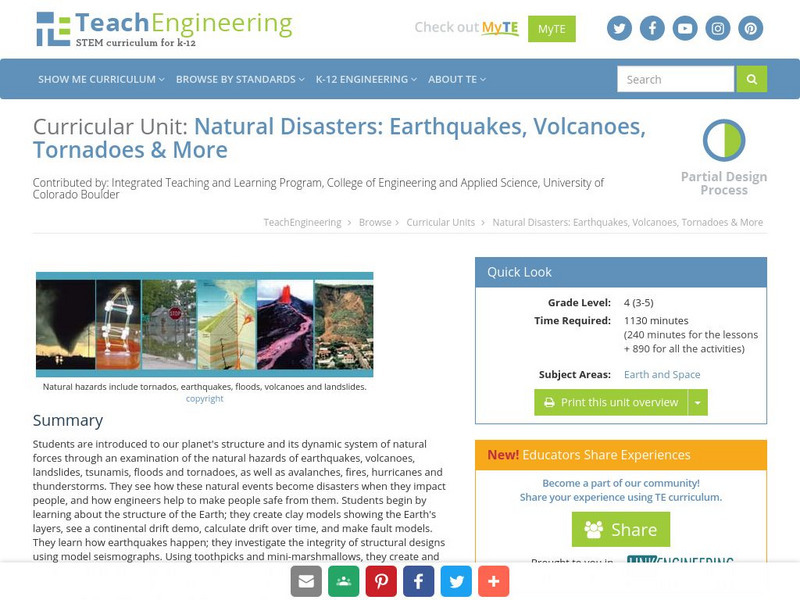Hi, what do you want to do?
Curated OER
The Magic School Bus Dries Up
Students learn along with Ms. Frizzle's class. In this Magic School Bus lesson plan, students work in small groups to find out if foods they eat contain water.
Curated OER
Advanced Matching--Weather
Here's a simple matching worksheet to help ELL learners practice weather related vocabulary words. Learners match the weather vocabulary word on the right with the correct definition on the left.
K12 Reader
Extreme Weather
What is thunder? After reading a short article about extreme weather, middle schoolers must use information in the text to explain this weather phenomenon.
Curated OER
Grandma Thinks It's Cake Baking Weather
Second graders listen to a read aloud of Patricia Polacco's book "Thunder Cake" to explain how daily life has changed over the past 150 years.
Curated OER
Weather Forecast
Students explore the vocabulary for making statements about the weather in various cities. They respond with the use of the appropriate interpretive strategies to show the directions in the taget language for placing weather symbols on...
Curated OER
Reading Comprehension-Grade 2
In this grade 2 reading comprehension worksheet, students read several short passages, answering 1-3 multiple choice comprehension questions after each. Answers are included.
Curated OER
Thermochemistry
In this thermochemistry worksheet, students calculate the enthalpy of vaporization as well as the write the thermochemical expression for the production of the chemical reaction.
Other
K 3 Learning Pages: Web Resources Thunderstorms
Check out this comprehensive list of web resources on thunderstorms and safety. Students and teachers will benefit from the links found on this site.
University of Illinois
University of Illinois Urbana Champaign: Hail and Rain
Find out how hail is produced. You will discover the relationship between hail and thunderstorms.
USA Today
Usa Today: Understanding Clouds and Fog
Learn about the different kinds of clouds, their location in the sky, how they form, their influence on the weather, and unusual cloud shapes.
University Corporation for Atmospheric Research
Ucar: Thunderstorms
Right now there are about two thousand thunderstorms going on around the world. While common, they can be dramatic with intense rain, hail, wind, lightning, thunder, and even tornadoes.
Read Works
Read Works: April Showers
[Free Registration/Login Required] An informational text about rain, thunderstorms, and rainbows in the spring. A question sheet is available to help students build skills in reading comprehension.
University of Illinois
University of Illinois Urbana Champaign: Severe Storms
This site talks about severe storms. Topics include the dangers of thunderstorms, types of thunderstorms, components of thunderstorms, tornadoes, and modeling.
TeachEngineering
Teach Engineering: Natural Disasters
Students are introduced to our planet's structure and its dynamic system of natural forces through an examination of the natural hazards of earthquakes, volcanoes, landslides, tsunamis, floods and tornados, as well as avalanches, fires,...
Dan Satterfield
Dan's Wild Weather Page: Precipitation
Find out about what causes precipitation and perform activities that teaches how precipitation forms.
PBS
Pbs Learning Media: Severe Weather
Observe various severe weather phenomena in this image gallery from WGBH. Weather is the combination of factors -- temperature, wind, snow or rain, and sunlight and clouds -- that happen in a specific place at a specific time. Sometimes...
USA Today
Usa Today: Rising Air Creates Spring, Summer Ice
This article gives you basic information on hail. There are links at the bottom of the page to how hail forms, how updrafts breed hail and thunderstorms.
SMART Technologies
Smart: Weather
Students will learn about the six common weather conditions: sunshine, wind, rain, snow, fog, and thunderstorms.
McREL International
Mc Rel: Thunder Clouds [Pdf]
A worksheet regarding rain, clouds, thunder and lightening.
University Corporation for Atmospheric Research
Ucar: Weather Fronts
When a front passes over an area, it means a change in the weather. Many fronts cause weather events such as rain, thunderstorms, gusty winds and tornadoes.



















